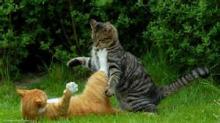Cats are known as solitary survivors yet a recent survey found that 44% of cat owning households had more than one cat.
Cats in general prefer not to fight. Instead they use visual and audible communication to avoid physical confrontations and adapt to living in a group through the development of social structures.
Sharing a home can be difficult for cats and can result in stress-related behaviours (such as urine marking) and/or inter-cat aggression. Physical restrictions on space and limited options for avoiding each other when living in our homes can mean that the location and availability of resources is key. Ensuring each cat has access to food and water bowls, litter trays and exit/entry points to the home without having to interact with each other, helps each cat cope when living close to others.
Cats can display aggression subtly such as blocking each other, staring, spending most of the time up high or hiding, changes in food consumption, grooming changes or stress-related behaviours, as well as physical interactions. Aggression can often be seen in cats newly introduced to each other or between cats that have previously been friendly however an event has resulted in aggression. These events can include a change in the home (such as renovation) or when a cat returns from time away (such as at the vets). Aggression can also result from a cat being in pain (or if it has an underlying medical problem), so in cases of inter-cat aggression it is advisable for cats to be examined by their vet.
In addition, when a new cat is brought home and introduced to a resident cat, aggression can be due to territorial and/or fear related issues.
What can owners do if their cats are aggressive to each other?
Firstly, cats should be separated and confined alone to prevent injury and further damage to their relationship. Owners should avoid punishing the cats for fighting as arousal, anxiety and the risk of injury increases.
Cats use pheromones to communicate with each other and to reassure themselves. By scent swapping, we can reacquaint each cat without any physical contact. This involves rubbing a cotton cloth on the chin of one of the cats (an area that produces pheromones, so that pheromones and the cat’s general smell are picked up) and then leaving it in the room with the other cat and vice versa. During this time, each cat should have access to their own resources. If a cat is displaying stress-related behaviours, then the use of a synthetic copy of the feline facial pheromone can help support the cat during this time as we want each cat to be comfortable in their own space whilst being introduced to the other cat’s smell and pheromones.
The door that physically separates the cats can then be used to encourage peaceful coexistence. Over time, controlled contact between the cats should be increased, e.g. cats on harnesses, highly palatable food at separate ends of a large room. Gradually reduce the distance between the cats, assessing the cats for any reactivity towards the other. Once there is no tension when they are relatively close, the owners can try to allow the cats to have monitored free access to each other. It can be difficult to predict how well the cats will get on and sometimes the relationship will not be repaired, so it may be best for one of the cats to be rehomed.
Now there is an extra tool available for owners who have cats that display aggression in the home. The cat appeasing pheromone is released by a queen when she is nursing her kittens to encourage a feeling of safety for them and also a bond between them. A synthetic copy of this pheromone (Feliway Friends) is available as a diffuser which should be plugged in the area where cats spend most of their time (usually where they sleep) and has been shown to reduce signs of aggression between resident cats.
In order to help the increasing population of cats in multicat homes, we need to help owners understand the need for good resource management in their homes and the importance of slowly introducing any new cat to a resident cat.
If you would like to discuss this with one of our vets or nurses, please call the practice – 01363 772860.


